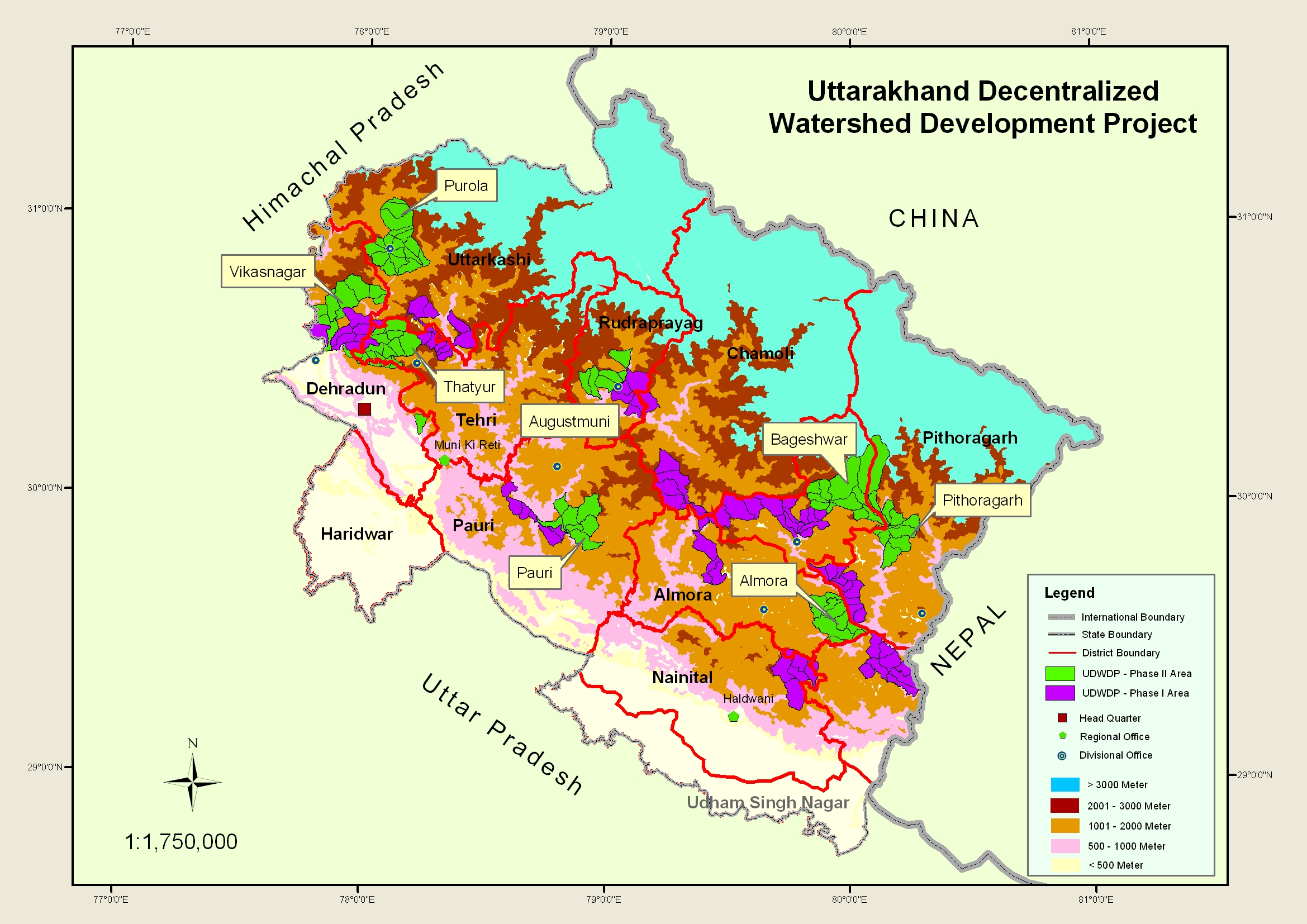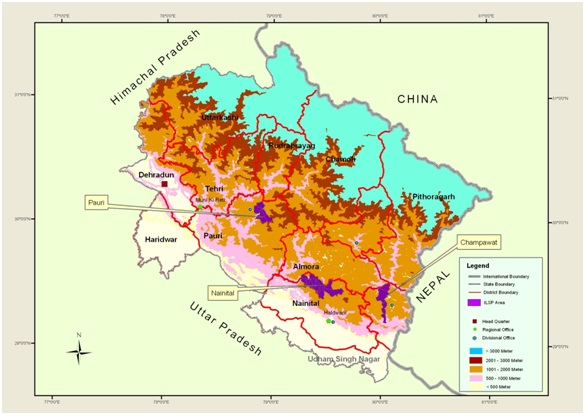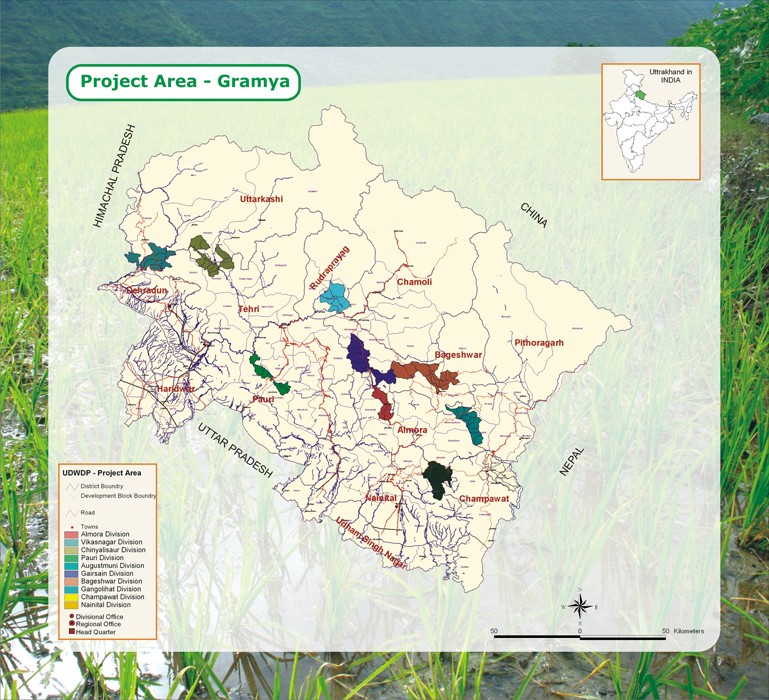Completed Projects
| S.No | Project Name | Duration | Area | Expenditure | Execution |
|---|---|---|---|---|---|
| 1 | Uttarakhand Decentralized Watershed Development Project(UDWDP) Phase-II | 2014 to 2022 | District Almora,Uttarkashi,Dehradun,Tehri,Rudraprayag,Pauri,Pithoragarh, Bageshwar and Model MWS(raipur)(82 MWS) | 170.0 million US$ | By GP (Gram Panchayat) |

|
Details of Project Area Selected for UDWDP – II |
||||||||||
|
DISTRICT |
Development Blocks |
No. of MWS |
Area (Ha.) |
Forest Area (Ha.) |
Agriculture Area (Ha.) |
Blank (Ha.) |
Gram Panchayat |
Revenue Villages |
||
|
No. |
Aera (Ha.) |
No. |
Area (Ha.) |
|||||||
| Almora |
Dhauladevi, Bhasiyanchana |
9 |
28396 |
14987 |
12303 |
1106 |
85 |
24340.64 |
186 |
23835.00 |
| Uttarkashi |
Mori, Naugaon, Purola |
17 |
45103 |
31233 |
9727 |
4143 |
67 |
10268.67 |
119 |
10012.56 |
| Dehradun |
Kalsi, Chakrata |
9 |
29242 |
8778 |
8270 |
12194 |
49 |
23012.69 |
74 |
21925.85 |
| Tehri |
Jaunpur |
13 |
31730 |
11977 |
8306 |
11447 |
72 |
18641.86 |
151 |
18553.44 |
| Rudraprayag |
Ukhimath, Jakholi, Augustmuni |
6 |
19201 |
11609 |
7449 |
143 |
65 |
8572.05 |
119 |
8429.67 |
| Pithoragarh |
Munsiyari, Didihat, Berinag |
9 |
25739 |
17206 |
6350 |
2383 |
59 |
22069.89 |
137 |
20568.19 |
| Bageshwar |
Kapkot |
11 |
55296 |
35666 |
6672 |
12920 |
48 |
33328.47 |
82 |
33964.28 |
| Pauri |
Pokhara, Ekeshwar |
7 |
26713 |
9373 |
10980 |
6360 |
57 |
10549.00 |
185 |
10451.14 |
| Model MWS |
Raipur |
1 |
2417 |
1365 |
789 |
95 |
7 |
2232.85 |
13 |
2232.85 |
|
18 |
82 |
263837 |
142194 |
70846 |
50791 |
509 |
153016.11 |
1066 |
149972.984 |
|
ABOUT THE PROJECT
Watershed is a hydrological unit of an area draining to a common outlet point. It is recognized as an ideal unit for planning and development of land, water and vegetation resource. Watershed concept has been used extensively because of importance of water balance in the study of ecosystems. Integrated watershed management covering an area from the highest point (ridge line) to the outlet is, therefore, the process of formulating, implementing and managing a course of actions involving natural and human resources in a watershed. It takes into account all the factors operating within the watershed.With time the watershed management concept has evolved into a decentralized and participatory approach with financial autonomy to the PRIs, (legal institution under 73rd amendment) thereby improving and ensuring efficient process delivery system. In watershed management the decision making regarding uses and modification of all categories of lands and water within the watershed are made in an iterative process with participation of all stakeholders in the Gram Panchayats. The repeated coming together and discussion provides opportunity to all stakeholders to balance diverse objectives for enhancement of productivity not only of individually owned resources but also of common property resources, and to consider how their cumulative actions may ensure long term sustainable use of all the natural resources.
Since the last decade it has been realized that ensuring livelihood opportunities and food security of the rural inhabitants is must for a sustainable watershed management approach thus focus on increasing the productivity of rainfed areas and ensuring livelihood opportunity for poorest of the poor is the mandate of the project.

PROJECT OBJECTIVE
To increase the efficiency of natural resource use and productivity of rain-fed agriculture by participating communities in selected micro-watersheds of the State of Uttarakhand.
The project objective was achieved by
- (a) supporting sustainable natural resource management through treating watersheds comprehensively at micro-watershed level;
- (b) increasing productivity on arable lands through providing extension services;
- (c) increasing rural incomes through enhancing agribusiness development for target farmers and alternative livelihoods for vulnerable households;and
- (d) as needed, providing response to an eligible crisis or emergency in the target micro-watersheds.
This project will be based on joint relationship among three entities: (i) village communities and GPs; (ii) WMD; and (iii) NGOs and other service providers. All these three stakeholders will fulfill their respective roles and responsibilities for the project to be successful.
PROJECT BENEFICIARIES
The project is expected to benefit about 55605 households in the hills, ranging from 700 m to 2,700 m above sea level spread over 263837 ha area in 82 MWS(including 1 model MWS). In supporting comprehensive watershed treatment at micro-watershed level, the proposed UDWDP II, locally known as Gramya II would target 509 GPs, which are contiguous to the Gramya I supported GPs. This would enhance natural resource base and improve sustainability. The target GPs would be selected according to the Government of India?s Common Guidelines for Watershed Development Projects. In addition, the project would also support the farmer federations formed by Gramya I to ensure their sustainability.
PROJECT COST & PERIOD
The total cost of the project is 170.0 million US$ with IDA Credit as 121.2 million US$ (71.3%), State contribution as 45.8 million US$ (27.0%) and beneficiary contribution as 3.0 million US$ (1.7%). The project period will be for seven years i.e. from 2014 to 2021.

PROJECT COMPONENTS
Component 1: Social Mobilization and Participatory Watershed Planning (US$ 30.0 Million)
(a).Mobilization of GPs in order to prepare integrated and coordinated GPWDPs including, inter alia, the identification of specific interventions to increase effective land use and water resource management and develop agriculture and income generation activities.
(b).Development of watershed treatment plans to guide the preparation and implementation of GPWDPs.
Sub Component 2 a. Watershed Treatment and Water Source Sustainability (US$78.5 Million)
b) perimeter rehabilitation with Napier and other grasses
c) forestry activities (e.g., plantations and nursery development) and
d) promotion of alternate energy sources (e.g., biogas plants, solar cookers, water mills, and pine briquette production).
Sub Component 2 b. Rainfed Area Development (US$11.8 million, of which IDA US$9.5 million)
Component 3: Enhancing Livelihood Opportunities (US$18.7 million, of which IDA US$14.9 million)
Sub Component 3 a. Agribusiness Support (US$9.1 million, of which IDA US$7.2 million)
Component 4: Knowledge Management and Project Coordination (US$31.0 million, of which IDA US$20.1 million)
Sub-component 4a: Knowledge Management (US$11.7 million, of which IDA US$9.3 million)-
| S.No | Project Name | Duration | Area | Expenditure | Execution |
|---|---|---|---|---|---|
| 1 | Reconstitution Of Watershed Management Directorate by giving a permanent form to the watershed management department. Nominating Watershed Management Directorate as the nodal agency for Watershed-based projects executed by all departments. 2004-2012: Commencement of Uttarakhand Decentralized Watershed Development Project (GRAMYA) under Panchayati Raj Institution. | Sep 2004 – March 2012 | District Pauri,U.S Nagar and Nainital(24 MWS),573 sq. km. | ₹488 Crore | By GP (Gram Panchayat) |
|
Financing Plan (million US$) |
||||
| Source | Local | Foreign | Total | %age |
| State | 16.62 | 0.00 | 16.62 | 18.6% |
| World Bank | 68.87 | 0.75 | 69.62 | 77.9% |
| Beneficiary Contribution | 3.11 | 0.00 | 3.11 | 3.5% |
| Total | 88.60 | 0.75 | 89.35 | 100% |

|
Project Component | ||||||||||||||||||||||||||||||||||||||||||||||||||||||||||||||||||||||||||||||||||||||||||||||||||||||||||||||
| S.NO. | Project Component | Sub Component | % age of Project Cost | |||||||||||||||||||||||||||||||||||||||||||||||||||||||||||||||||||||||||||||||||||||||||||||||||||||||||||
|---|---|---|---|---|---|---|---|---|---|---|---|---|---|---|---|---|---|---|---|---|---|---|---|---|---|---|---|---|---|---|---|---|---|---|---|---|---|---|---|---|---|---|---|---|---|---|---|---|---|---|---|---|---|---|---|---|---|---|---|---|---|---|---|---|---|---|---|---|---|---|---|---|---|---|---|---|---|---|---|---|---|---|---|---|---|---|---|---|---|---|---|---|---|---|---|---|---|---|---|---|---|---|---|---|---|---|---|---|---|---|
| 1 | Participatory Watershed Development and Management |
|
|
|||||||||||||||||||||||||||||||||||||||||||||||||||||||||||||||||||||||||||||||||||||||||||||||||||||||||||
| 2 | Enhancing Livelihood Opportunities |
|
|
|||||||||||||||||||||||||||||||||||||||||||||||||||||||||||||||||||||||||||||||||||||||||||||||||||||||||||
| 3 | Institutional Strengthening |
|
|
|||||||||||||||||||||||||||||||||||||||||||||||||||||||||||||||||||||||||||||||||||||||||||||||||||||||||||
| ||||||||||||||||||||||||||||||||||||||||||||||||||||||||||||||||||||||||||||||||||||||||||||||||||||||||||||||
Gramya-I Project Documents
| 1 | Integrated Livelihood Support Project (ILSP)-Component-2: Participatory Watershed Development | 2012-2021 | District Pauri,Champawat and Nainital | ₹286.94 crores. | By GP (Gram Panchayat) |
|
Background The Uttarakhand Watershed Development Unit (UWDU) through Govt. of Uttarakhand has received a credit from IFAD (International Fund for Agriculture Development) for implementation of Integrated Livelihoods Support Project, (ILSP). The UWDU is PIA for Project Component -2: Participatory Watershed Development. The project development objective (PDO) is: The overall objective (goal) of ILSP will be to reduce poverty in hill districts of Uttarakhand. This would be achieved via the more immediate development objective of “enable rural households to take up sustainable livelihood opportunities integrated with the wider economy”. Location: Uttarakhand is a hill state in the north-west of India, covering 53,483 sq km with a population of about 10.0 million (2011 census). Nine of its 13 districts are classed as hill districts, covering 77% of the area of the state, but with only 44% of the population. Livelihoods are still predominantly rural, but most economic and population growth has also been in the plains, which are becoming industrialised. Poverty: Uttarakhand is one of the poorest states in India. The major driver of rural poverty is the difficult mountain environment. Land holdings are very small (average 0.8 ha) and fragmented into 6 or 7 different locations. Tiny terraced plots on steep hillsides makes mechanisation virtually impossible. Shallow and immature soils require high levels of organic matter, but yields are very low. Agriculture is very largely for subsistence, but very few households are able to produce enough food to last for more than three or four months. People rely on non-farm earnings and safety net programmes. With few rural employment opportunities, more and more people are migrating to jobs outside of hill districts. Between one third and one half of households send migrants and, as it is mainly men who migrate, this places more and more of the burden of farm labour, as well as domestic work, on women. Lack of labour, low productivity and wild animal damage are all contributing to land being abandoned, and it is said that as much as 30% of land in the hills that was once used to grow crops is no longer in production. Rationale: The justification for ILSP is the need to stop the deterioration of the productive infrastructure, make farm labour more productive and farming more remunerative, and hence provide incentives for people to invest their time and resources in agriculture. Despite the disadvantages that agriculture faces in the hill areas, Uttarakhand does have the advantage of cooler temperatures at higher altitudes, allowing production of off-season vegetables and temperate fruits. The horticultural sector is less developed than in the other hill states, so there is considerable potential for growth, as there are other niche products such as spices, medicinal and aromatic plants, and nuts. There is little use of modern varieties, mineral fertilisers and other inputs. Only about 10% of land in hill districts is irrigated. Most households keep cattle or buffalo, but improved crossbreds are relatively scarce, there is minimal investment in feeding and heath care. With 65% of the state covered in forest, damage to crops by wild animals is a major problem. Farmers and others report that the climate in Uttarakhand is changing, with rainfall patterns becoming more erratic. Another area with growth potential is tourism. However more needs to be done to ensure that local people fully participate in, and benefit from, this sector. |

|
Strategy The strategy behind ILSP will be to adopt a two pronged approach to building livelihoods in hill districts. The first of these is to support and develop the food production systems which remain the main means of support for most households. This involves improving technologies for production of traditional food crops and livestock, and developing supporting services for input supply and marketing of any surpluses. To make food production more secure the project will also contribute to watershed development to conserve water and soil resources. ILSP will also support the production of fodder and other non-timber forest products in community forest areas (Van Panchayats). The second main thrust of the project is to generate cash incomes via the introduction and expansion of cash crops. These would be grown on a significant scale for markets outside of the state. There is already significant production of off-season vegetables, such as potatoes, tomatoes and peas, and some fruit. This can be expanded through improved technologies and the development of new production areas, with returns to farmers improved via better marketing and by value addition. ILSP will also support non-farm livelihoods, especially community involvement in rural tourism. Many people migrate to jobs outside of the hill areas, and ILSP will support vocational training to help people obtain more remunerative employment. |

|
Components of ILSP Component 1: Food security and livelihood enhancement Component 2: Participatory Watershed Development Component 3: Livelihood financing Component 4: Project coordination and monitoring Under the ILSP Project PSWMD (Project Society Watershed Management Directorate) is having responsibility of implementing component-2(Participatory Watershed Development). , Participatory Watershed Development: To implement component-2 Watershed Management Directorate (WMD) will use processes that have been established through a series of watershed development projects in the state, but with an increased focus on food security, livelihoods and market linkages. It will protect and improve the productive potential of the natural resources in selected watersheds, alongside the promotion of sustainable agriculture with formation of PGs and LCs, and with improved access to markets. The component would cover a total of 22 micro-watershed (MWS) covering an area of about 70194 ha in 3 clusters in 3 districts (Pauri, Champawat and Nainital), with a population of 103321. Sub-components and activities to be implemented under Component-2 are as follows: (a) Participatory Watershed Management The involvement of stakeholders at grass root level is a vital element of watershed management. NGOs/TAs will be hired for social awareness and participatory planning for smooth running of project. Watershed Development activities will be implemented on the basis of a budget allocation provided at the GP level calculated based on watershed area and total population. Within this allocation the communities will have to prioritize, implement, operate and maintain watershed and other priority investments of the village. The various activities will be Soil and Moisture Conservation Measures, water harvesting structures, plantations, pasture development, livestock support and encourage use of alternate energy sources. (b) Food Security & Scaling Up Producer Groups (PG) would be formed to introduce, promote and disseminate improved technologies and farming practices. Technical agency will be hired to support the project subcomponent by forming PGs,VPGs & LC and providing them technical support of agribusiness development, financial support, new agriculture technologies, value chain development. (c) Access to Market: Under this sub-component, the project will: (i) identify the market potential for the agricultural produce; (ii) develop collection centres and good storage facilities; (iii) create centres for value addition of the raw produce; and (iv) identify market linkages, develop market information and logistic services. The private sector (NGOs and private firms) will be encouraged to play a major role in supporting agribusiness development. To up-scale production, develop markets for high value crops, and to leverage producers' access to production and marketing services, the project would support farmers to organise their PG and VPG into Livelihood Collectives(LCs). The project would provide input support to LCs. For financial support, PG/LC would be linked with banks and other financial institutions. (d)Monitoring & Evaluation and Knowledge Management: (i) Capacity Building of Watershed Committees, CBOs and all level of stakeholders. (ii) Information, Education and Communication: targeted messages to increase general awareness about the project, terms of participation and transparency. (iii) Project Management, Coordination, Monitoring and Evaluation. |
| S.No | Project Name | Duration | Area | Expenditure | Execution |
|---|---|---|---|---|---|
| 1 | South Bhagirathi Phase-I Project financed by the European Economic Community (E.E.C) | 1982 to 1988 | District Tehri Garhwal(6 MWS),172 sq. km | ₹6.46 Crore | Through Line Department |
| 2 | Himalayan Integrated Watershed Management Project financed by the World Bank | 1983 to 1992 | District Pauri and Almoral(75 MWS),2867 sq. km. | ₹80.49 Crore | Through Line Department upto the year 1987-88 |
| 3 | South Bhagirathi Phase-II Project financed by the European Economic Community (E.E.C) | 1988 to 1996 | District Tehri Garhwal(18 MWS),356 sq. km. | ₹19.56 Crore | by the project administration under the Unified command. |
| 4 | Bhimtal Project Project financed by the European Economic Community (E.E.C) | 1993 to December 2001 | District Nainital(8 MWS),216 sq. km. | ₹12.68 Crore | by the project administration under the Unified command. |
| 5 | Doon Valley Watershed Management Project Project financed by the European Economic Community (E.E.C) | 2019 - 2024 | District Dehradun,Tehri and Nainital(62 MWS),2408 sq. km. | ₹102.12 Crore | by the project administration under the Unified command. |
| 6 | IWDP (Hills-II) Shiwalik Project Project financed by the World Bank | 1999 to 2005 | District Pauri,U.S Nagar and Nainital(24 MWS),573 sq. km. | ₹189 Crore | by VDC. |
